

3 Steps for Educators to Take Advantage of OERs. Bill TaylorOpen Educational Resources (OERs) have been recognized as one option for solving the challenges of today’s educators.
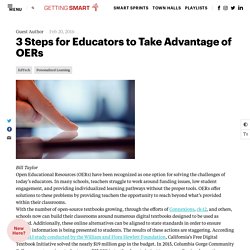
In many schools, teachers struggle to work around funding issues, low student engagement, and providing individualized learning pathways without the proper tools. OERs offer solutions to these problems by providing teachers the opportunity to reach beyond what’s provided within their classrooms. With the number of open-source textbooks growing, through the efforts of Connexions, ck-12, and others, schools now can build their classrooms around numerous digital textbooks designed to be used as needed.
Additionally, these online alternatives can be aligned to state standards in order to ensure quality information is being presented to students. The results of these actions are staggering. In addition to listed perks, OERs create new opportunities for personalized learning pathways. Learning objects - e-Learning kit - Guides at McGill Library. Wiley defines learning objects as "any digital resource that can be reused to support learning" (2000, p7).
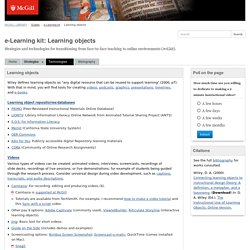
With that in mind, you will find tools for creating videos, podcasts, graphics, presentations, timelines, and e-books. Difference Between Open University and Distance Education (with Characteristics and Comparison Chart) - Key Differences. Open Educational Resources.
Discover. Free online courses. Distance Learning and The Physics Classroom. The Physics Classroom and Distance Learning We've had a phrase in our heads for a long time that sums up our mission: "serving students, teachers and classrooms.
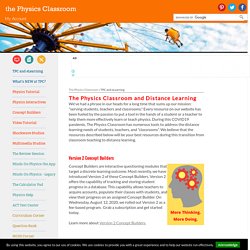
" Every resource on our website has been fueled by the passion to put a tool in the hands of a student or a teacher to help them more effectively learn or teach physics. During this COVID19 pandemic, The Physics Classroom has numerous tools to address the distance learning needs of students, teachers, and "classrooms". We believe that the resources described below will be your best resources during this transition from classroom teaching to distance learning. Version 2 Concept Builders Concept Builders are interactive questioning modules that target a discrete learning outcome. Learn more about Version 2 Concept Builders.
Physics Simulations The Interactives section of our website c onsists of a large collection of interactive simulations. Minds On Physics the App. CC Open Education Platform - CC Global Network. What is the Open Education Platform?

The Creative Commons Open Education Platform is a space for open education advocates and practitioners to identify, plan and coordinate multi-national open education content, practices and policy activities to foster better sharing of knowledge. This platform is open to all interested people working in open education. We work in a transparent, professional, ethical and public manner on the following goals: 1.
Open Textbooks. Open Educational Resources (OER): Digital Materials for Today's Knowledge Ecology by COERLL UT on Prezi. OER Issues: Apples, Orchards and Infrastructure. Open Education Resource (OER) advocates are gathered this week in Vancouver for the 12th annual Open Education conference.

Reflecting their energy and their evangelism, the home page of the conference web site proclaims “Open Education resources provide a massive, high quality open content infrastructure on top of which innovative people and organizations are building a new generation of educational models. Methodologically rigorous research is demonstrating that these OER-based models can be extremely effective in reducing the cost of education and improving student learning.”
Clearly the OER movement is fueled by good intentions and great aspirations. Several reports and events leading into this week’s Open Ed conference may help to advance the OER cause. The JCHE article is worth reading. (Sidebar: David Wiley, a corporate officer of Lumen Learning, obviously has a vested interest in research that documents the pedagogical value of OER course materials. These are overlapping issues. 1.1 Introduction to OER - Open Educational Resources. The development of materials by instructors is an important step in learning and teaching.
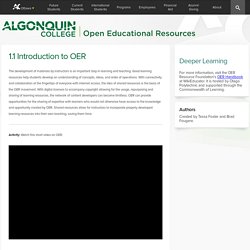
Good learning resources help students develop an understanding of concepts, ideas, and order of operations. With connectivity and collaboration at the fingertips of everyone with internet access, the idea of shared resources is the basis of the OER movement. With digital licenses to accompany copyright allowing for the usage, repurposing and sharing of learning resources, the network of content developers can become limitless. OER can provide opportunities for the sharing of expertise with learners who would not otherwise have access to the knowledge and opportunity created by OER. Shared resources allow for instructors to incorporate properly developed learning resources into their own teaching, saving them time. Curation as a tool for teaching and learning (with images) · hbailie. “A curator is an expert learner.
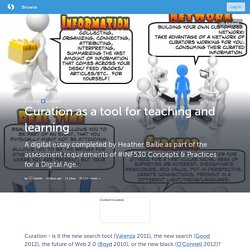
Instead of dispensing knowledge, he creates spaces in which knowledge can be created, explored, and connected.” (Siemens, 2007). According to Boyd (2010) curators help people to focus their attention on the most relevant and important information streams. Hewlett Foundation - Open Educational Resources. Open Learning Network. Scientists Are Putting Tens of Thousands of Sea Fossils Online. Published on Written by Erin Blakemore Some 100 million years ago, much of what is now North America was underwater.

The body of water scientists calls the Western Interior Seaway covered a swath of land that stretched over the entire Midwest. But its secrets have been preserved in countless fossils—and now, over 100,000 of these fossils are being digitized. Eight institutions are in the midst of a gigantic project to get specimens from the long-lost seaway online. The project is ambitious: The NSF award notes that there are an estimated 164,000 samples to digitize. Fossils aren’t the only clues the Seaway left behind: Chalk deposits made of compacted shells can still be seen in Kansas, and rocks and sediments can still be spotted throughout the Midwest. But to share their secrets, those fossils have to be available—and to become available, they must be painstakingly scanned and classified.
Read more at Smithsonian Trackback from your site. The College of Earth and Mineral Sciences' OER initiative.